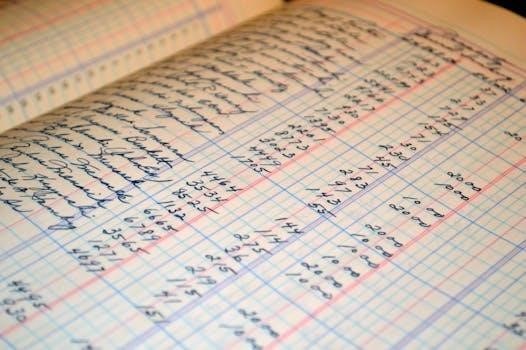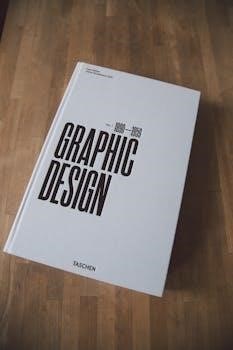Understanding Mixed Numbers and Improper Fractions
Mixed numbers combine whole numbers and fractions․
Improper fractions have numerators larger than denominators․
Converting between them is essential for fraction operations, as seen in 5th-grade worksheets․ Practicing with customizable PDF worksheets reinforces these concepts, aiding real-life problem-solving involving quantities․
Defining Mixed Numbers
Mixed numbers represent a quantity greater than one, combining a whole number and a proper fraction, such as 3 5/7․ They are commonly encountered in everyday situations like measuring ingredients or determining lengths․
Understanding mixed numbers is crucial before converting them to improper fractions, as highlighted in grade 5 fraction worksheets․ These worksheets often include exercises where students match mixed numbers with corresponding visual representations or equivalent improper fractions․
The concept of mixed numbers builds upon basic fraction knowledge, emphasizing that a mixed number represents the sum of a whole number and a fraction less than one․ For example, 2 1/2 is the same as 2 + 1/2․
Customizable PDF worksheets offer ample practice in identifying and working with mixed numbers, preparing students for more complex fraction operations; Recognizing mixed numbers is a foundational skill for mastering fraction concepts․ Mixed numbers will always have a whole number component and a proper fraction component․ Learning these concepts allows for real-world mathematical applications․
Defining Improper Fractions
Improper fractions are fractions where the numerator is greater than or equal to the denominator, such as 7/3․ This means the fraction represents a quantity of one or more wholes․ Unlike proper fractions, which are less than one, improper fractions can be converted into mixed numbers․
Understanding improper fractions is essential for converting mixed numbers, a skill often practiced in grade 5 fraction worksheets․ These worksheets provide exercises where students identify and work with improper fractions, reinforcing their understanding of fraction concepts․
Improper fractions can be visualized as representing more than one whole, with the numerator indicating the total number of parts and the denominator indicating the size of each part; For example, 5/4 represents one whole and one-quarter․
Customizable PDF worksheets offer practice in converting improper fractions to mixed numbers and vice versa, strengthening students’ grasp of fraction equivalence․ Recognizing and manipulating improper fractions are crucial for advanced fraction operations․ These fractions are an important step to mastering mathematical operations and concepts․ Improper fractions are often used in algebraic applications․

Converting Mixed Numbers to Improper Fractions⁚ Step-by-Step
Converting mixed numbers involves a few key steps․ These steps are reinforced through practice worksheets․ Mastering this conversion is crucial for solving various math problems․
This skill is also very important in grade 5 fraction worksheets․
Multiply the Whole Number by the Denominator
The first step in converting a mixed number to an improper fraction involves multiplying the whole number part by the denominator of the fractional part․
This multiplication is a foundational arithmetic operation that combines the whole quantity with the fractional units․ For instance, in the mixed number 3 5/7, you would multiply 3 (the whole number) by 7 (the denominator)․ This calculation determines how many fractional units are represented by the whole number portion of the mixed number․
This multiplication step is critical because it establishes a common unit for both parts of the mixed number, allowing them to be combined into a single fraction․ The result of this multiplication will be used in the subsequent step to calculate the new numerator of the improper fraction while keeping the original denominator intact․ This process is commonly practiced in grade 5 fraction worksheets, aiding in understanding fraction concepts․ Multiplying the whole number by the denominator is a crucial skill that helps bridge the gap between mixed numbers and improper fractions․

Add the Numerator to the Result
After multiplying the whole number by the denominator, the next step involves adding the numerator of the original fraction to the result obtained in the previous step․
This addition combines the whole number portion (now expressed in terms of the denominator) with the fractional part, giving the total number of fractional units․
For example, if you had 3 5/7, you multiplied 3 by 7 to get 21․ Now, you add the numerator 5 to this result⁚ 21 + 5 = 26․ This sum, 26, becomes the new numerator of the improper fraction․ This step is crucial because it accurately represents the total quantity as a single fraction․
It ensures that the value of the mixed number is preserved when converted to an improper fraction․ This process is fundamental to working with fractions and is often reinforced through practice problems in grade 5 fraction worksheets․ Adding the numerator to the result is a key step that ensures accurate conversion between mixed numbers and improper fractions, solidifying understanding and skills in fraction manipulation․
Keep the Original Denominator
After performing the multiplication and addition steps in converting a mixed number to an improper fraction, the final step is to retain the original denominator․ This means the denominator of the fractional part of the mixed number becomes the denominator of the resulting improper fraction․
For example, if you started with the mixed number 2 1/4, and after multiplying 2 by 4 and adding 1 you obtained 9, the improper fraction would be 9/4․ The denominator, 4, remains unchanged․
Maintaining the original denominator is essential because it indicates the size of the fractional units being counted․ Changing the denominator would alter the value of the fraction, leading to an incorrect conversion․ This principle is consistent across all mixed number to improper fraction conversions and is reinforced through various exercises, including those found in grade 5 fraction worksheets․
By keeping the original denominator, the improper fraction accurately represents the same quantity as the mixed number, ensuring mathematical integrity․ This step solidifies understanding and proficiency in fraction manipulation, making it a cornerstone of fraction-related problem-solving․

Worksheet Applications for Practice
Worksheets offer structured practice converting mixed numbers to improper fractions․ Grade 5 worksheets provide targeted exercises․ Customizable PDF worksheets allow tailored practice․ These resources build proficiency, reinforcing fraction concepts and skills․ Regular practice ensures mastery and confidence in mathematical operations․
Grade 5 Fraction Worksheets
Grade 5 fraction worksheets focusing on mixed numbers and improper fractions are valuable resources for solidifying understanding and skill․ These worksheets often include exercises where students convert mixed numbers to improper fractions and vice versa, reinforcing the relationship between these two representations of fractions․ Many worksheets provide visual aids, such as fraction bars or number lines, to help students visualize the conversion process and develop a deeper conceptual understanding․
These worksheets typically progress in difficulty, starting with simpler conversions and gradually introducing more complex problems․ They may also include word problems that require students to apply their knowledge of mixed numbers and improper fractions to solve real-world scenarios․ Such problems help students see the practical applications of these concepts and develop their problem-solving skills․
Furthermore, grade 5 fraction worksheets often incorporate a variety of question formats, such as multiple-choice, fill-in-the-blank, and open-ended questions, to cater to different learning styles and assess understanding in multiple ways․ Answer keys are usually provided to allow students to check their work and identify areas where they need additional practice․
By utilizing these worksheets, students can gain confidence in their ability to work with mixed numbers and improper fractions, which is a foundational skill for future math studies․
Customizable PDF Worksheets
Customizable PDF worksheets offer a flexible and effective way to practice converting mixed numbers to improper fractions․ These resources allow educators and parents to tailor the difficulty and content to meet individual student needs․ With customizable options, you can adjust the range of numbers used, the number of problems per worksheet, and even the specific types of fractions included․ This level of control ensures that students receive targeted practice in areas where they need the most support․
The PDF format makes these worksheets easily accessible and printable, allowing for convenient use in both classroom and home settings․ Many websites offer user-friendly interfaces that guide you through the customization process, making it simple to create worksheets that align with specific learning objectives․ You can also often choose to include answer keys for self-checking or teacher assessment․
Customization can extend to the visual aspects of the worksheet as well․ Some platforms allow you to add instructions, examples, or even graphics to enhance student engagement and understanding․ This adaptability makes customizable PDF worksheets a valuable tool for differentiating instruction and providing personalized learning experiences for students of all levels․ Furthermore, the ability to create unlimited variations ensures that students can continue practicing without encountering the same problems repeatedly․

Real-Life Applications and Word Problems
Understanding mixed numbers and improper fractions extends far beyond the classroom; it is crucial for solving real-life problems․ Word problems provide an excellent way to apply these concepts in practical contexts․ For instance, consider scenarios involving cooking, where recipes often use fractional measurements․ Converting mixed numbers to improper fractions helps determine the total quantity of ingredients needed․
Construction and carpentry also rely heavily on fractions for measuring lengths, widths, and heights․ Calculating the amount of material needed for a project often requires converting mixed numbers to improper fractions to ensure accuracy․ In financial applications, understanding fractions is essential for calculating interest rates, discounts, and proportions of investments․
Word problems can be designed to mimic these real-world situations, challenging students to apply their knowledge of mixed numbers and improper fractions․ These problems might involve scenarios such as dividing a pizza among friends, calculating the distance covered in multiple runs, or determining the amount of paint needed for several walls․ By solving these problems, students develop a deeper appreciation for the practical significance of fractions and enhance their problem-solving skills․ The ability to convert between mixed numbers and improper fractions becomes a valuable tool for navigating everyday challenges․
